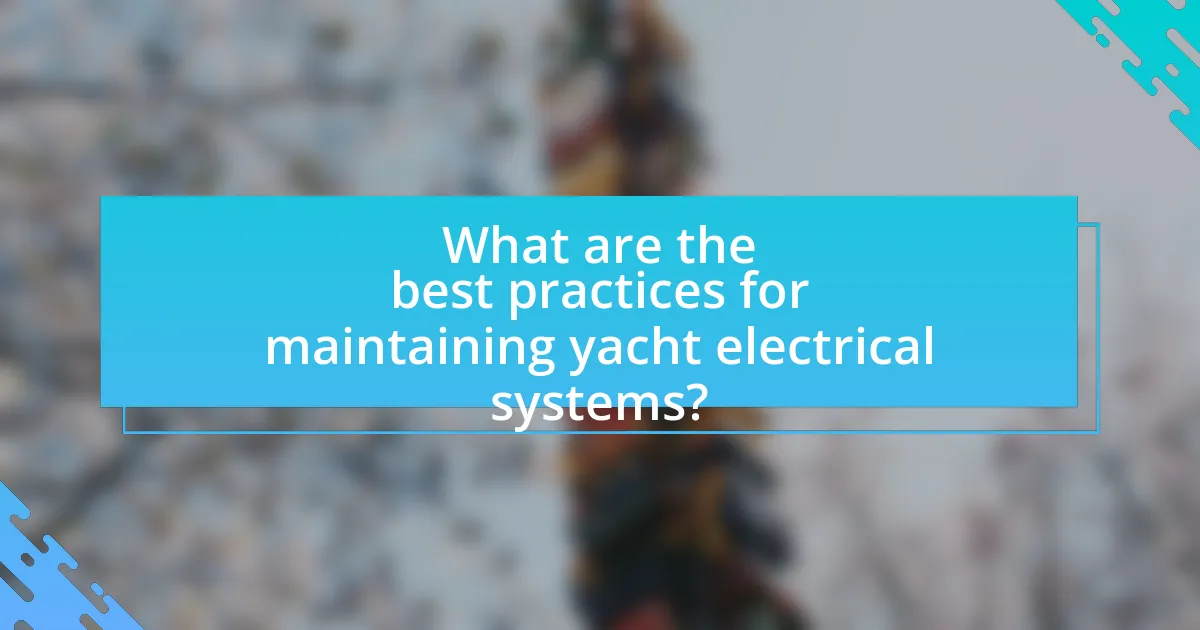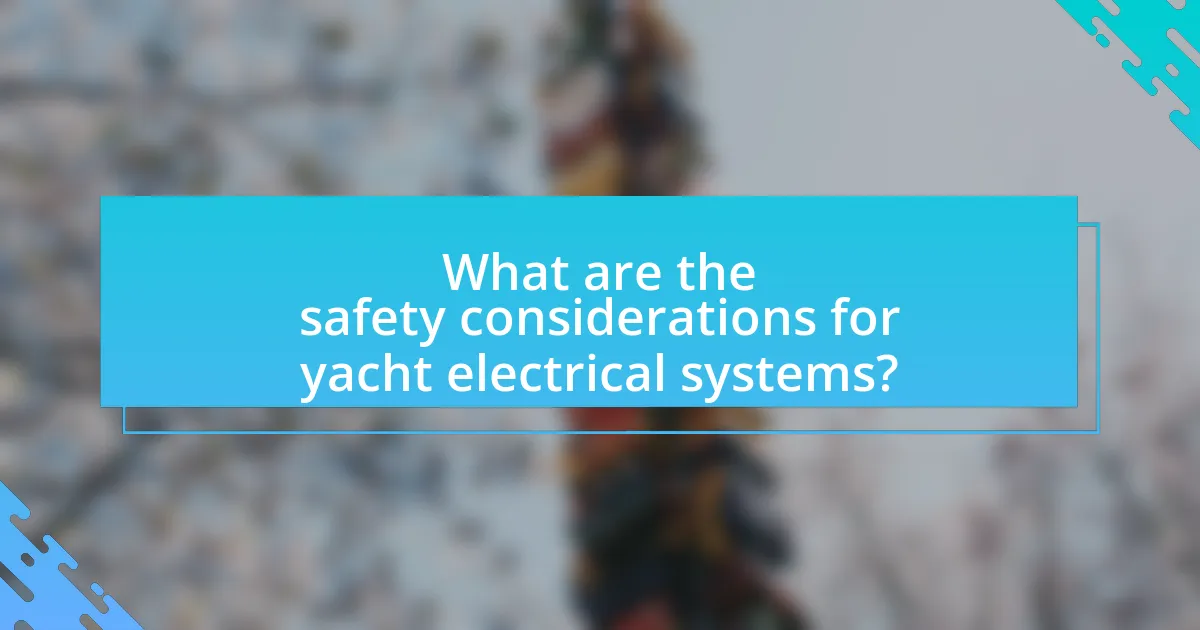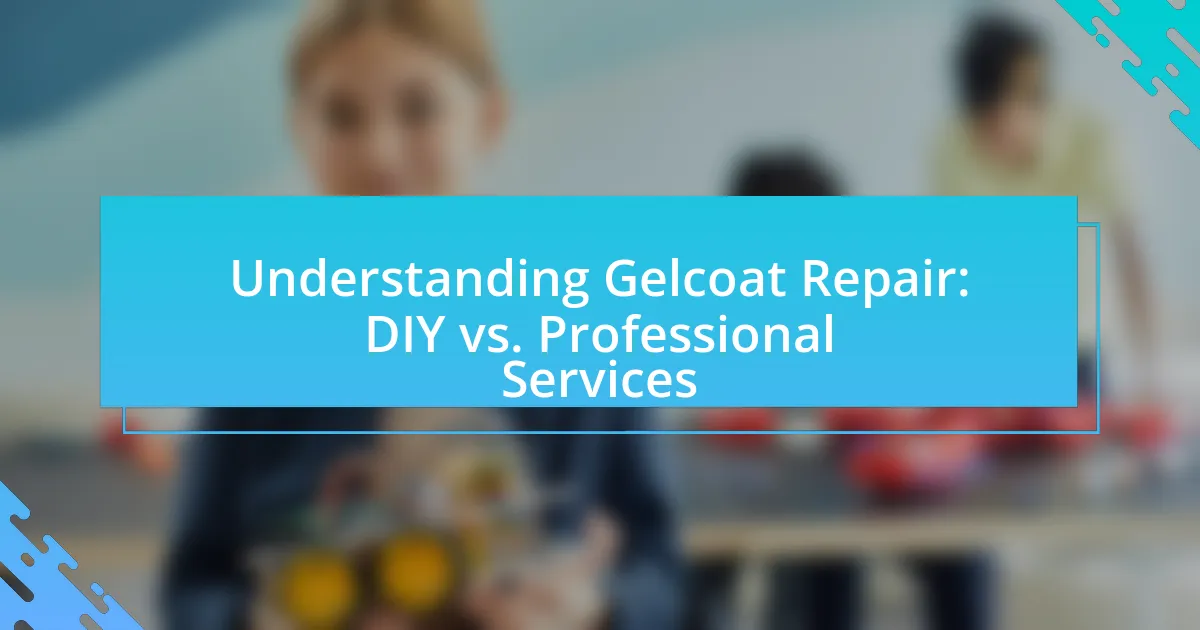The article focuses on best practices for maintaining yacht electrical systems, emphasizing the essential components such as batteries, inverters, chargers, and wiring. It outlines the functions of these components, including how batteries store energy and how inverters convert power for onboard use. The article also highlights the importance of regular inspections, maintenance tasks, and safety considerations to prevent electrical failures and hazards. Additionally, it provides practical tips for troubleshooting common issues and resources for further education on yacht electrical systems.
What are the essential components of a yacht’s electrical system?
The essential components of a yacht’s electrical system include the battery, alternator, inverter, shore power connection, circuit breakers, and wiring. The battery stores electrical energy, while the alternator charges the battery when the engine is running. An inverter converts DC power from the battery to AC power for onboard appliances. The shore power connection allows the yacht to connect to external power sources when docked. Circuit breakers protect the electrical system from overloads, and wiring distributes electricity throughout the yacht. Each component plays a critical role in ensuring the yacht’s electrical system operates efficiently and safely.
How do batteries function within the yacht’s electrical system?
Batteries in a yacht’s electrical system store and supply electrical energy to power various onboard systems. They function by converting chemical energy into electrical energy through electrochemical reactions, allowing for the operation of essential equipment such as navigation systems, lighting, and appliances. Typically, yachts utilize lead-acid or lithium-ion batteries, which provide reliable power and can be recharged through the yacht’s alternator or shore power connections. The capacity and health of these batteries directly impact the yacht’s operational efficiency and safety, as they must be properly maintained to ensure longevity and performance.
What types of batteries are commonly used in yachts?
The types of batteries commonly used in yachts include lead-acid batteries, lithium-ion batteries, and gel batteries. Lead-acid batteries are traditional and widely used due to their cost-effectiveness and reliability, particularly in starting engines and powering onboard systems. Lithium-ion batteries are gaining popularity for their lightweight, higher energy density, and longer lifespan, making them suitable for energy-intensive applications. Gel batteries, a subtype of lead-acid batteries, offer advantages such as reduced maintenance and better performance in deep-cycle applications. These battery types are essential for ensuring efficient operation of a yacht’s electrical systems.
How can battery maintenance extend their lifespan?
Battery maintenance can significantly extend their lifespan by ensuring optimal charging, preventing deep discharges, and maintaining clean terminals. Regularly checking and maintaining the charge level prevents sulfation, a process that can reduce capacity and lifespan. Additionally, keeping terminals clean and free from corrosion enhances conductivity and efficiency, which is crucial for battery performance. Studies indicate that proper maintenance can increase battery life by up to 50%, demonstrating the importance of these practices in prolonging battery functionality.
What role do inverters and chargers play in yacht electrical systems?
Inverters and chargers are essential components of yacht electrical systems, as they convert and manage electrical energy for various onboard applications. Inverters transform direct current (DC) from batteries into alternating current (AC), enabling the use of standard household appliances, while chargers replenish the batteries by converting AC power from shore power or generators back into DC. This dual functionality ensures that yachts can operate essential systems and devices efficiently, maintaining power availability during voyages. The importance of these components is underscored by the fact that a well-functioning inverter and charger system can significantly enhance the overall reliability and performance of a yacht’s electrical infrastructure.
How do inverters convert power for onboard use?
Inverters convert power for onboard use by transforming direct current (DC) from batteries into alternating current (AC) suitable for household appliances. This process involves the inverter using electronic circuits to switch the DC input on and off rapidly, creating a square wave that is then filtered to produce a smooth AC waveform. The efficiency of this conversion typically ranges from 80% to 95%, depending on the inverter design and load conditions, ensuring that onboard electrical systems can operate effectively without relying solely on shore power or generators.
What are the best practices for maintaining chargers?
The best practices for maintaining chargers include regularly inspecting connections, keeping the charger clean, and ensuring proper ventilation. Regular inspections help identify any loose or corroded connections that can affect performance. Cleaning the charger prevents dust and debris buildup, which can lead to overheating. Proper ventilation is crucial as it allows heat dissipation, reducing the risk of damage. Following these practices can extend the lifespan of chargers and ensure efficient operation.
Why is proper wiring crucial for yacht electrical systems?
Proper wiring is crucial for yacht electrical systems because it ensures safety, reliability, and efficiency in power distribution. Inadequate or faulty wiring can lead to electrical failures, which may cause equipment malfunctions or even fire hazards. According to the National Fire Protection Association, electrical failures are a leading cause of marine fires, emphasizing the importance of proper installation and maintenance of wiring systems. Additionally, well-designed wiring minimizes voltage drops and energy losses, enhancing the overall performance of onboard electrical systems.
What are the common wiring issues that can arise?
Common wiring issues that can arise include loose connections, corrosion, and insulation damage. Loose connections can lead to intermittent power loss or electrical shorts, while corrosion, often caused by exposure to moisture, can degrade the conductivity of wires and connectors, resulting in increased resistance and potential failure. Insulation damage, which may occur due to wear and tear or rodent activity, can expose wires and create short circuits, posing fire hazards. These issues are frequently reported in marine environments, where saltwater and humidity exacerbate electrical problems, making regular inspections and maintenance essential for safety and reliability.
How can one ensure safe and effective wiring practices?
To ensure safe and effective wiring practices, one must adhere to established electrical codes and standards, such as the National Electrical Code (NEC) in the United States. Following these codes ensures that wiring installations are safe, reducing the risk of electrical fires and equipment damage. Additionally, using high-quality materials, such as marine-grade wiring and connectors, is crucial for durability and resistance to corrosion in a marine environment. Regular inspections and maintenance of wiring systems help identify potential issues before they escalate, ensuring ongoing safety and functionality. According to the American Boat and Yacht Council (ABYC), proper installation and maintenance can significantly extend the lifespan of electrical systems on yachts.

What are the best practices for maintaining yacht electrical systems?
The best practices for maintaining yacht electrical systems include regular inspections, proper cleaning, and timely replacements of components. Regular inspections should focus on checking wiring for corrosion, ensuring connections are tight, and testing battery health, as these actions can prevent electrical failures. Cleaning should involve removing dirt and salt buildup from terminals and connections, which can enhance conductivity and prolong the lifespan of the electrical system. Additionally, timely replacements of worn-out batteries, fuses, and circuit breakers are crucial, as these components are essential for safe and efficient operation. Following these practices helps ensure reliability and safety in yacht electrical systems.
How often should routine inspections be conducted?
Routine inspections should be conducted at least once every six months. This frequency is recommended to ensure the proper functioning and safety of electrical systems on a yacht, as regular checks can identify potential issues before they escalate into significant problems. According to the American Boat and Yacht Council (ABYC), biannual inspections help maintain compliance with safety standards and prolong the lifespan of electrical components.
What specific areas should be checked during inspections?
During inspections of a yacht’s electrical systems, specific areas that should be checked include the battery condition, wiring integrity, circuit breakers, and electrical connections. The battery condition is crucial as it affects the overall power supply; checking for corrosion and ensuring proper voltage levels are essential. Wiring integrity must be assessed for signs of wear, fraying, or damage, as compromised wiring can lead to electrical failures or hazards. Circuit breakers should be tested to ensure they function correctly and can handle the electrical load, preventing overloads. Lastly, electrical connections must be inspected for tightness and corrosion, as loose or corroded connections can lead to power loss or short circuits. Regular checks in these areas help maintain the safety and efficiency of the yacht’s electrical systems.
How can one identify signs of wear or damage?
To identify signs of wear or damage in yacht electrical systems, one should regularly inspect components for corrosion, frayed wires, and loose connections. Corrosion can appear as discoloration or rust on terminals and connectors, indicating potential electrical failure. Frayed wires may expose conductive materials, increasing the risk of short circuits. Loose connections can lead to intermittent power loss, which is often noticeable during operation. Regular visual inspections and testing with a multimeter can help detect these issues early, ensuring the reliability of the electrical systems.
What maintenance tasks should be performed regularly?
Regular maintenance tasks for yacht electrical systems include inspecting and cleaning battery terminals, checking and tightening electrical connections, testing circuit breakers and fuses, and ensuring that all wiring is free from corrosion and damage. These tasks are essential to prevent electrical failures and ensure the safety and efficiency of the yacht’s systems. For instance, according to the American Boat and Yacht Council (ABYC), regular inspection of battery terminals can significantly reduce the risk of electrical shorts and improve battery life.
How can cleaning electrical connections improve performance?
Cleaning electrical connections can significantly improve performance by enhancing conductivity and reducing resistance. When connections are dirty or corroded, they can impede the flow of electricity, leading to inefficient operation of electrical systems. For instance, a study by the National Renewable Energy Laboratory found that corrosion can increase resistance by up to 50%, which can cause overheating and failure of electrical components. Regular cleaning ensures optimal contact between surfaces, thereby maximizing the efficiency and reliability of the yacht’s electrical systems.
What is the importance of checking fuses and circuit breakers?
Checking fuses and circuit breakers is crucial for ensuring the safety and functionality of electrical systems on a yacht. Regular inspections help identify potential issues such as overloads or short circuits, which can lead to electrical fires or equipment damage. According to the National Fire Protection Association, electrical failures are a leading cause of boat fires, emphasizing the need for proactive maintenance. By routinely checking these components, yacht owners can prevent costly repairs and enhance the overall reliability of their electrical systems.
How can one troubleshoot common electrical issues?
To troubleshoot common electrical issues, one should first identify the symptoms, such as flickering lights or non-functioning outlets. Next, check the circuit breaker for tripped switches, as this is a common cause of electrical problems. If the breaker is fine, inspect wiring connections for signs of damage or corrosion, which can disrupt electrical flow. Additionally, using a multimeter can help measure voltage and continuity, confirming whether circuits are functioning properly. According to the National Fire Protection Association, faulty wiring is a leading cause of electrical fires, emphasizing the importance of thorough inspections and prompt repairs.
What steps should be taken when experiencing power failures?
When experiencing power failures on a yacht, the first step is to check the circuit breakers and fuses to identify any tripped circuits or blown fuses. This action is crucial because it often resolves minor issues without further intervention. Next, inspect the power source, such as the batteries or generator, to ensure they are functioning correctly and have sufficient charge. According to the American Boat and Yacht Council, regular maintenance of electrical systems, including battery checks, can prevent power failures. If the problem persists, it is essential to assess the wiring for any visible damage or loose connections, as faulty wiring can lead to power disruptions. Finally, if these steps do not resolve the issue, contacting a qualified marine electrician is advisable to diagnose and repair more complex electrical problems.
How can one diagnose issues with onboard electronics?
To diagnose issues with onboard electronics, one should systematically check the power supply, inspect connections, and utilize diagnostic tools such as multimeters. First, verifying that the power supply is functioning correctly ensures that the electronics receive adequate voltage. Next, inspecting connections for corrosion or loose wires can reveal physical issues that disrupt functionality. Finally, employing diagnostic tools like multimeters allows for precise measurement of voltage, current, and resistance, helping to identify faulty components. This methodical approach is supported by industry practices that emphasize the importance of thorough checks in maintaining reliable electrical systems on yachts.

What are the safety considerations for yacht electrical systems?
Safety considerations for yacht electrical systems include proper installation, regular maintenance, and adherence to marine electrical standards. Ensuring that all electrical components are installed according to manufacturer specifications and marine regulations minimizes the risk of electrical failures and hazards. Regular inspections of wiring, connections, and circuit breakers help identify wear or damage that could lead to short circuits or fires. Additionally, using appropriate circuit protection devices, such as fuses and breakers, is crucial to prevent overloads. According to the American Boat and Yacht Council (ABYC), following their standards can significantly enhance safety by reducing the likelihood of electrical accidents on yachts.
How can one prevent electrical fires on a yacht?
To prevent electrical fires on a yacht, regularly inspect and maintain all electrical systems and components. This includes checking wiring for wear, ensuring connections are secure, and replacing any damaged insulation. According to the National Fire Protection Association, faulty wiring is a leading cause of marine fires, emphasizing the importance of routine checks. Additionally, installing circuit breakers and using marine-grade electrical components can significantly reduce fire risks. Regularly testing smoke detectors and having fire extinguishers on board further enhances safety measures against electrical fires.
What are the best practices for circuit protection?
The best practices for circuit protection include using circuit breakers, fuses, and surge protectors to prevent overloads and short circuits. Circuit breakers automatically interrupt the flow of electricity when a fault is detected, while fuses provide a sacrificial element that melts to break the circuit under excessive current. Surge protectors safeguard against voltage spikes, which can damage sensitive electronic equipment. Implementing these devices ensures safety and reliability in electrical systems, particularly in marine environments where conditions can be unpredictable. Regular maintenance and inspections of these protective devices are essential to ensure their functionality and effectiveness.
How can one ensure proper grounding of electrical systems?
To ensure proper grounding of electrical systems, one must connect all electrical equipment to a common ground point, typically a grounding plate or rod that is in direct contact with the water. This practice minimizes the risk of electrical shock and equipment damage by providing a safe path for stray currents. According to the National Electrical Code (NEC), grounding systems should be tested regularly for continuity and resistance to ensure effectiveness, with a maximum resistance of 25 ohms recommended for grounding electrodes. Additionally, using marine-grade materials for connections and ensuring that all grounding conductors are securely fastened and free from corrosion further enhances the reliability of the grounding system.
What safety equipment should be onboard for electrical emergencies?
Safety equipment that should be onboard for electrical emergencies includes a fire extinguisher rated for electrical fires, insulated gloves, a first aid kit, and a voltage tester. These items are essential for effectively managing electrical hazards. Fire extinguishers specifically rated for electrical fires (Class C) can safely extinguish fires caused by electrical equipment without conducting electricity. Insulated gloves protect individuals from electric shock while handling live wires. A first aid kit is crucial for addressing any injuries that may occur during an electrical incident. Lastly, a voltage tester allows for the safe checking of electrical circuits before any maintenance or repair work is performed, ensuring that the equipment is de-energized.
How can one effectively use fire extinguishers for electrical fires?
To effectively use fire extinguishers for electrical fires, one must utilize a Class C fire extinguisher, which is specifically designed for electrical fires. When an electrical fire occurs, the individual should first ensure their safety by disconnecting the power source if it is safe to do so. Next, they should aim the extinguisher at the base of the fire and use a sweeping motion to extinguish the flames. It is crucial to maintain a safe distance from the fire while using the extinguisher. According to the National Fire Protection Association (NFPA), using the correct type of extinguisher is vital, as using water or a non-Class C extinguisher can exacerbate the fire and pose additional risks.
What are the essential tools for electrical maintenance and repair?
The essential tools for electrical maintenance and repair include a multimeter, wire strippers, screwdrivers, pliers, and electrical tape. A multimeter is crucial for measuring voltage, current, and resistance, allowing technicians to diagnose electrical issues accurately. Wire strippers are necessary for removing insulation from wires to make secure connections. Screwdrivers, both flathead and Phillips, are used for securing and removing electrical components. Pliers assist in gripping and bending wires, while electrical tape is vital for insulating and securing connections to prevent short circuits. These tools are fundamental for ensuring safe and effective electrical maintenance and repair in various applications, including yacht electrical systems.
What are some practical tips for maintaining your yacht’s electrical systems?
To maintain your yacht’s electrical systems effectively, regularly inspect and clean all connections and terminals to prevent corrosion. Corrosion can lead to poor conductivity and system failures, so using a corrosion inhibitor on terminals can enhance longevity. Additionally, check the battery levels and connections frequently; maintaining a full charge and ensuring tight connections can prevent unexpected power loss. It is also crucial to test circuit breakers and fuses periodically to ensure they are functioning correctly, as faulty breakers can lead to electrical hazards. Lastly, consider using a marine-grade multimeter to monitor voltage and current levels, which helps in identifying potential issues before they escalate. Regular maintenance of these components ensures the reliability and safety of your yacht’s electrical systems.
How can regular maintenance save costs in the long run?
Regular maintenance can save costs in the long run by preventing major failures and extending the lifespan of electrical systems on a yacht. Consistent upkeep, such as checking connections, cleaning components, and replacing worn parts, reduces the likelihood of unexpected breakdowns that can lead to expensive repairs. For instance, a study by the National Marine Manufacturers Association indicates that regular maintenance can reduce repair costs by up to 30% over time, as proactive measures address issues before they escalate. This approach not only minimizes downtime but also enhances the overall efficiency of the yacht’s electrical systems, leading to lower operational costs.
What resources are available for yacht electrical system education?
Resources available for yacht electrical system education include online courses, textbooks, and hands-on workshops. Online platforms such as Udemy and Coursera offer specialized courses on marine electrical systems, covering topics like wiring, troubleshooting, and safety protocols. Textbooks like “Marine Electrical and Electronics Bible” by John C. Payne provide comprehensive knowledge on yacht electrical systems. Additionally, organizations such as the American Boat and Yacht Council (ABYC) offer certification programs and workshops that focus on best practices and standards in marine electrical systems. These resources ensure that individuals gain both theoretical and practical knowledge essential for maintaining yacht electrical systems effectively.















